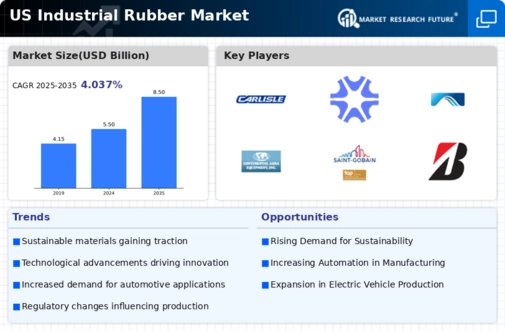The industrial rubber market in the US is characterized by a competitive landscape that is both dynamic and multifaceted. Key growth drivers include the increasing demand for durable and high-performance materials across various sectors, such as automotive, construction, and manufacturing. Major players like Goodyear Tire & Rubber Company (US), Bridgestone Americas, Inc. (US), and Michelin North America, Inc. (US) are strategically positioned to leverage innovation and sustainability initiatives. For instance, Goodyear Tire & Rubber Company (US) focuses on enhancing its product offerings through advanced materials technology, while Bridgestone Americas, Inc. (US) emphasizes its commitment to environmental sustainability, which collectively shapes a competitive environment that prioritizes both performance and ecological responsibility.
In terms of business tactics, companies are increasingly localizing manufacturing to reduce lead times and optimize supply chains. The market structure appears moderately fragmented, with several key players exerting considerable influence. This fragmentation allows for niche players to thrive, while larger corporations consolidate their market share through strategic partnerships and acquisitions. The collective influence of these key players fosters a competitive atmosphere that encourages innovation and responsiveness to market demands.
In November 2025, Michelin North America, Inc. (US) announced a significant investment in a new manufacturing facility aimed at producing sustainable rubber products. This strategic move is expected to enhance their production capacity while aligning with the growing consumer preference for environmentally friendly materials. The establishment of this facility not only strengthens Michelin's operational footprint but also positions the company as a leader in sustainable practices within the industrial rubber sector.
Similarly, in October 2025, Bridgestone Americas, Inc. (US) unveiled a partnership with a tech firm to integrate AI-driven analytics into their supply chain management. This initiative is likely to enhance operational efficiency and reduce costs, thereby improving their competitive edge. By leveraging technology, Bridgestone aims to streamline its processes and respond more effectively to market fluctuations, which is crucial in a rapidly evolving industry.
In December 2025, Goodyear Tire & Rubber Company (US) launched a new line of high-performance tires designed specifically for electric vehicles. This product introduction reflects a strategic pivot towards catering to the growing electric vehicle market, which is anticipated to expand significantly in the coming years. By aligning their product development with emerging automotive trends, Goodyear is positioning itself to capture a larger share of this evolving market segment.
As of December 2025, current competitive trends indicate a pronounced shift towards digitalization, sustainability, and AI integration. Strategic alliances are increasingly shaping the landscape, enabling companies to pool resources and expertise to drive innovation. The competitive differentiation is likely to evolve from traditional price-based competition to a focus on technological advancements, sustainable practices, and supply chain reliability. This transition underscores the importance of adaptability and forward-thinking strategies in maintaining a competitive advantage in the industrial rubber market.

















Leave a Comment